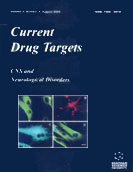Abstract
Anxiety and depression are psychiatric disorders that constitute a major health concern worldwide, and new pharmacological approaches with the potential for improved efficacy and decreased side effect profiles relative to currently marketed drugs are desired. Since the identification of corticotropin releasing factor (CRF) by Vale and colleagues in 1981, an extensive research effort has solidified the importance of this 41 amino acid peptide in mediating the bodys behavioral, endocrine, and autonomic responses to stress. The further identification of CRF receptor subtypes has provided compelling targets for novel pharmaceutical agents. The present review focuses on the potential of non-peptidic antagonists of the CRF1 receptor subtype as a novel therapeutic approach for the treatment of anxiety and depression. The first section reviews preclinical and clinical evidence implicating CRF, in general, and CRF1 receptors, in particular, in anxiety and depression. Clinical studies have demonstrated a dysfunctional hypothalamic-pituitary-adrenal (HPA) axis and/or elevated CRF levels in depression and in some anxiety disorders. Preclinical data utlilizing correlational methods, genetic models, and exogenous CRF administration techniques in rodents and non-human primates supports a link between hyperactive CRF pathways and anxiogenic and depressive-like symptoms. Studies employing the use of receptor knockouts and selective, non-peptidic antagonists of the CRF1 receptor have demonstrated anxiolytic and antidepressant effects under certain types of laboratory conditions. A Phase II, open-label, clinical trial in major depressive disorder has reported that a CRF1 receptor antagonist was safe and effective in reducing symptoms of anxiety and depression. In the second section, a topological approach is used to describe the design strategies employed to produce potent, non-peptidic CRF1 receptor antagonists. Two main topologies, featuring a center core, a top side-chain, and a pending aromatic ring, can be used to characterize the vast majority of currently known CRF1 receptor antagonists. By exploiting some of these structural elements, pharmacological, physicochemical, and pharmacokinetic properties can be modulated and optimized. However, as a result of a relatively conservative iteration process during the structural optimization, the chemical space presently defined by the existing CRF1 receptor antagonists still remains fairly narrow. Expanding these structural and topological boundaries, while optimizing the “drug-like” properties of the CRF1 receptor antagonists, seems to be a common objective across pharmaceutical companies to maximize the chances for a clinical success in the near future.
 6
6

















